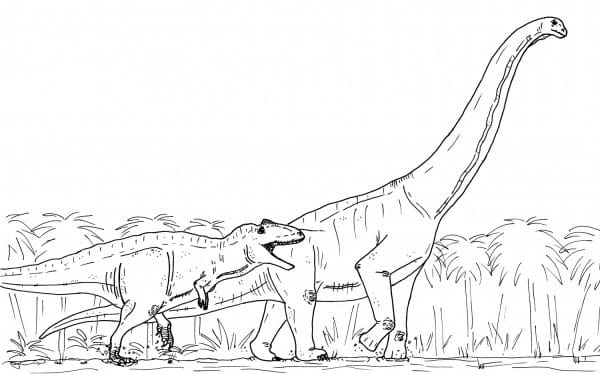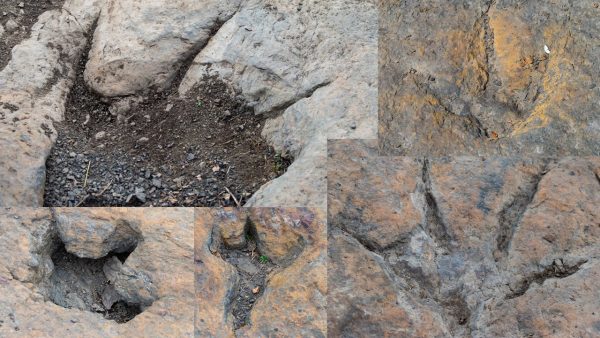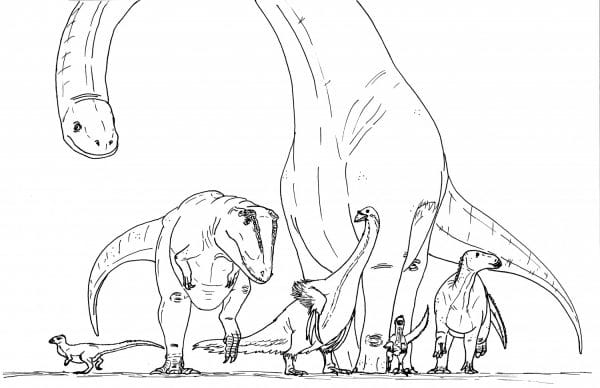
It’s a commonly (and incorrectly) held belief that all we’ll ever know about dinosaurs comes from their bones, and that people will never be able to get an understanding of dinosaur behavior and lifestyle. Dinosaurs left many different traces of their existence other than their fossilized skeletons, and one of the coolest has to be their footprints.
Fossilized footprints are known as ichnites to those in the biz, and have been found all over the world. Some of the first known to scientists were found in the northeastern United States in the early 19th century, years before skeletal fossils of dinosaurs had even been recognized and described. Opinions on the maker of these prints ranged from giant birds to biblical monsters, but after good remains of dinosaurs were eventually found in Europe and America, the mystery was solved.
Paleontologists are interested in dinosaur footprints for a variety of reasons. Namely, because they’re something the animals left behind while they were still alive. There’s something of a mantra amongst those who study ichnites that bones are a record of an animal’s death, while prints are a record of life. And what lives these animals lived. Paleontologists can learn a surprising amount about the life and times of dinosaurs by carefully studying their footprints and the rock they’re preserved in.
The way dinosaurs moved, and the obstacles they encountered in their landscape, can be discerned from trackways. Want to know how fast a dinosaur could move? Or what its gait and posture were like? Trackways plus a little math can tell you! For a long time, it was once thought that dinosaurs generally dragged their tails along the ground the same way modern lizards do. Ignoring all the anatomical reasons why this is false (in some species, the tail would have had to be broken in order to have rested on the ground), there’s the simple fact that out of all the many dinosaur trackways known to science, almost none show any hint of a tail touching the ground at all. Simple evidence that dinosaurs were generally horizontal animals that held their tails more or less parallel to the ground.
We can also get hints of dinosaur social behavior by looking at trackways, and some particularly nice examples of this have come from northeastern British Colombia. One well-known case is the dinosaur prints of the Peace River Canyon, one of Dr. Phil Currie’s first projects as a paleontologist. Back in the 30’s the trackways of this mountain canyon were first studied by another legendary paleontologist, Charles Sternberg, and contain a big assemblage of prints from ornithopod dinosaurs (the ‘duck-bills’ and their earlier relatives). Currie’s team had been contracted to study the dinosaur tracks from this area because a dam set for imminent construction on the river would eventually cover the prints in deep, cold water forever. The wealth of trackways they found, from both juveniles and adults that seemed to be travelling together, suggested to them that big herbivorous dinosaurs were social animals. (Currie & Sarjeant, 1979).
These days, many of British Columbia’s dinosaur track sites are studied by two of the provinces’ most intrepid and tenacious paleontologists, Drs. Lisa Buckley and Rich McCrea. In 2014, they and colleagues described a rare trackway made by three tyrannosaurs near the town of Tumbler Ridge (McCrea et al., 2014). The prints seemed to indicate that the tyrannosaurs were travelling in the same direction at the same time, lending some support to the idea that these predators may have been at least somewhat social as well.
Tracks may also hint at predatory behavior as well, although this too is always hard to prove. One of the most famous examples of this is the trackways of the Paluxy River in Texas. First studied in the 1930’s by paleontologist Roland T. Bird, this now-submerged trackway bears prints from a collection of big sauropods and one large theropod all laid down at the same time and heading in the same direction (Farlow et al., 2010). Does this trackway represent a herd of plant-eaters being pursued by a predator? Some argue yes, and interpret one instance of a missing theropod print in the trackway to indicate a moment where the predator tried (unsuccessfully) to latch onto one of the herbivores. Many paleontologists though, always healthy skeptics, argue that this is fanciful and that we can’t assume anything more than these two different types of dinosaur were present at this site around the same time. While the scenario might not be correct, it’s still fascinating to imagine.

Hypothetical reconstruction of the dinosaurs responsible for the Paluxy River trakcway. By Nicholas Carter
We can learn a lot about dinosaur injuries and diseases as well from their footprints. Ichnites showing dislocated, swollen, or missing toes hint at the rough and sometimes violent lives these animals lived. Some trackways seem to have been left by animals that were limping as well, and it’s hard not to feel a little sympathy for these dinosaurs who left traces of their suffering in the ground beneath them.
The preservation of footprints is influenced by the environment that dinosaurs inhabited, or at least the ones they spent any degree of time in. This gives scientists clues as to the habitat preferences of some dinosaurs. For example, in northwestern Canada the tracks of ankylosaurs are fairly well known, and preserved in areas that would have been muddy swamps good for leaving footprints in. Perhaps these dinosaur sought refuge from big predators in habitats like these. Contra to this, horned dinosaur footprints seem to be very rare, perhaps indicating that they inhabited places where the preservation of footprints wasn’t favored. This might explain why, in places like Alberta, horned dinosaur bones are found all over the place, but their tracks are not.
In the Grande Prairie area where the Philip J. Currie Dinosaur Museum is located, we’re relatively wealthy when it comes to ichnites, and this allows paleontologists to infer what animals inhabited the ecosystem represented by the local Wapiti Formation 73 million years ago in the absence of full skeletal remains (Fanti et al., 2013). Our local tracks generally come from animals that aren’t surprising to find in rocks from late Cretaceous Alberta. Tracks possibly from frogs, salamanders, lizards, crocodiles, and marsupials represent the smaller, non-dinosaurian animals around at the time. Hadrosaur, tyrannosaur, and ankylosaur tracks hint at some of the dinosaur fauna from the region. While it’s not surprising that these animals lived in this area, and hadrosaur bones are becoming more and more common from the Wapiti Formation, tyrannosaur and ankylosaur material is sparse at best from here so far. And, as said earlier, horned dinosaur tracks are strangely absent despite our super dense ceratopsian bonebeds. An even more tantalizing ichnite from this area is a handprint from a very large pterosaur found southwest of Grande Prairie (Bell et al., 2012). While it’s impossible to tell exactly what sort of pterosaur left this handprint, the authors who described it thought it was likely to be from a large azhdarchid similar to the famous Quetzalcoatlus, with a wingspan of over 7 meters.
The study of ichnites is kind of a specialized science, and fossil footprints have their own taxonomic system separate from that of the animals who made them. The reason we give fossil footprints their own name and description is because it’s very hard, often impossible, to prove that a print or trackway was left by a specific animal species. We can’t go back and see the individual animal making the footprints we’re interested in, and thanks to factors like soft tissue and substrate distortion, animal footprints don’t often resemble the bottom of the feet that make them, especially the bones inside. In some cases, we can make educated guesses on what kind of prehistoric critter left certain footprints. This is unusually in cases where prints are found in rock units that also preserve skeletons. If there’s only one possible candidate known from fossil bones that could have made a print, we can be at least somewhat confident on a trackmaker’s identity.
For example, large 3-toed ichnites from the early Jurassic of Arizona have been ascribed to Dilophosaurus, as it’s the only known dinosaur from that age that could have made prints like that (Welles, 1971). There is, of course, the possibility that these prints were made by some other dinosaur that scientists haven’t found skeletal remains of. The best candidates for the Paluxy River theropod and sauropod trackway seem to be Acrocanthosaurus and Sauroposeidon respectively, as these may be the only dinosaurs known from this point in time in western North America that could have made these tracks. But there’s always room for doubt. Moving away from dinosaurs, an exciting recent discovery of Permian trackways from Prince Edward Island are suspected to have been made by the synapsid Dimetrodon.
Sometimes, however, there’s no specific candidate for a particular trackmaker. These cases can be maddeningly enigmatic, especially when tracks are found in unexpected places. In early May 2019, the Philip J. Currie Dinosaur Museum proudly co-hosted the annual Canadian Society of Vertebrate Paleontology conference- a meeting of vertebrate paleontologists and their students from all over the county. Part of this conference involved a group trip (that included myself) led by Drs. Buckley and McCrea to the Six Peaks Dinosaur Tracksite, a remote location deep in the mountains of northwestern British Columbia. Despite its rustic and isolated setting, this tracksite is phenomenally impressive and of the utmost interest to paleontologists. The dinosaur footprints here are preserved in the early Cretaceous Gething Formation, and the site contains traces of some fairly typical dinosaurs from this period in time, such as prints from Iguanodon-like ornithopods of varying sizes, and tracks of large carnosaurs. Small, very faint bird tracks were also found here, though what kind of prehistoric bird made them is uncertain.

A variety of dinosaur footprints from the Six Peaks Dinosaur Tracksite. Clockwise from the top left: sauropod, misc. theropod, therizinosaur, ornithopod w/ metatarsal impression, ornithopod. Photos by Nicholas Carter
But there’s (literally) bigger surprises at the Six Peaks site as well. The bones of long-necked sauropod dinosaurs have always been notably absent from Canadian rocks, as there’s just so few known exposures here dating back to times when these giants were common throughout North America. But strewn across a section of the Six Peaks site are the footprints of a pretty darn big sauropod, some of the best evidence that this type of dinosaur was, at some point, present this far north. What species this was exactly, and whether it was a resident or just passing through are unknown, but it’s exciting to think about.
There was another, stranger dinosaur who passed through the Six Peaks site as well. An unusual series of large, 4-toed tracks are present here. The shape of these tracks seem to indicate that they were left by a big theropod, but what theropod routinely walked with all four toes touching the ground? Unless they were navigating deep mud, the raised inner first toe of most theropods rarely ever contacted the ground, and this is not consiostently seen in any of the other Six Peaks theropod tracks. The answer lies in a bizarre family of theropods called the therizinosaurs. Looking like a freakish cross between a bird and a giant ground sloth, therizinosaurs were plant-eating theropods known mostly from Asia and the American southwest. Basal therizinosaurs from the early Cretaceous were smaller, lightly-built dinosaurs with long tails and agile legs. More advanced species from the late Cretaceous grew much larger, with barrel-shaped bodies, small heads, and long arms with enormous scythe-like claws. These later therizinosaurs, with their bulky torsos and stumpy legs, walked around with all four toes contacting the ground. So some kind of big therizinosaur, as unlikely as it seems, appears to be the only candidate for the 4-toed theropod tracks of northeastern British Columbia. Not only is this the first definitive record of these dinosaurs from Canada, but these tracks were laid down during a time when all known therizinosaurs were much smaller and lightly-built. How wild is that?

Hypothetical dinosaurs from the Six Peaks Tracksite. By Nicholas Carter
This is just the briefest of summaries on dinosaur footprints. There’s so much more to learn and discover from the traces that these animals left behind. We may never get to fully view non-avian dinosaurs as living, moving animals, but walking in the footsteps of giants can get us close.
By Nicholas Carter
References:
Bell, P.R., Fanti, F. & Sissons, R. 2012: A possible pterosaur manus track from the Late Cretaceous of Alberta. Lethaia, DOI: 10.1111/let.12006.
Currie, P. J. and Sarjeant, W. A. S., 1979. Lower Cretaceous dinosaur footprints from the Peace River Canyon, British Columbia, Canada. Palaeogeogr., Palaeoclimatol., Palaeoecol., 28: 103–115.
Fanti F, Bell PR, Sissons RL (2013). A diverse, high-latitude ichnofauna from the Late Cretaceous Wapiti Formation, Alberta. Cret Res 41: 256–269.
James O. Farlow, Mike O’Brien, Glen J, Kuban, Benjamin F. Dattilo, Karl T. Bates, Peter L. Falkingham, Laura Piñuela, Amanda Rose, Austin Freels, Cory Kumagai, Courtney Libben, Justin Smith, and James Wh (2010). Dinosaur tracksites of the Paluxy River (Glen Rose Formation, Lower Cretaceous), Dinosaur Valley State Park, Somervell County, Texas, USA. Fifth Jornadas Internacionales sobre Paleontología de Dinosaurios y su Entorno, Salas de los Infantes, Burgos, Spain, pp. 15–16.
McCrea RT, Buckley LG, Farlow JO, Lockley MG, Currie PJ, et al. (2014) A ‘Terror of Tyrannosaurs’: The First Trackways of Tyrannosaurids and Evidence of Gregariousness and Pathology in Tyrannosauridae. PLoS ONE 9(7): e103613. doi:10.1371/journal.pone.0103613
Welles, S. P. (1971). “Dinosaur footprints from the Kayenta Formation of northern Arizona”. Plateau. 44: 27–38.

